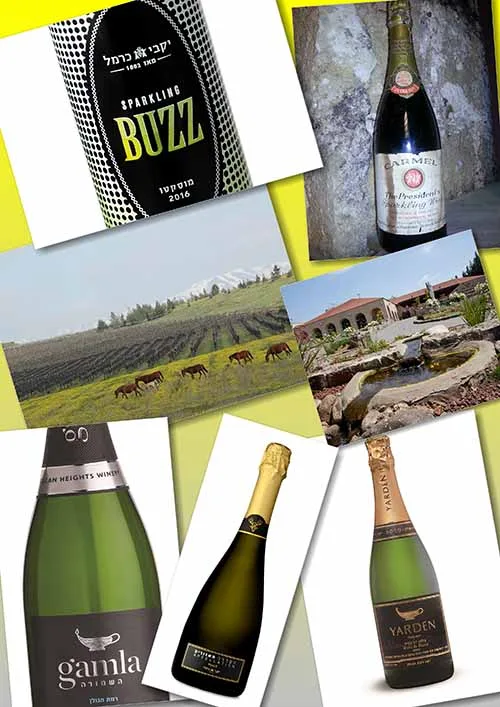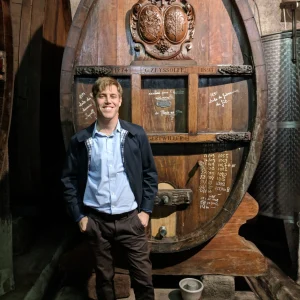This article first appeared in the Jerusalem Post Magazine.
Sparkling wine is the wine of fashion, partying and celebration. Whether on New Year’s Eve, at a wedding or at a birthday, it remains the classic wine to make a toast with. It is also symbol of success and happiness. Though it is a style of wine that has taken Israelis time to learn to appreciate, sparkling wines have become very popular here. The number of imported sparklers, mainly Cava from Spain or Prosecco from Italy, has increased dramatically. In fact anything with bubbles is ‘in’. In restaurants and bars throughout t Israel, people are ordering Cava, which has become the Israeli slang for any sparkling wine.
Champagne is the ultimate expression of the art, which is replicated by ‘traditional method’ sparkling wines made elsewhere. It is little known, but between the late 1950’s and 1980’s, Carmel produced genuine ‘méthode champenoise’ (aka Classic Method) sparkling wines. It was an expensive undertaking needing a special work force as everything was done by hand. There was no market for expensive sparkling wine in those days and so they eventually stopped production. It was too unprofitable. The only remaining clue of a champagne past, were the old pupitres (wine racks for riddling), which could be seen at the Rishon Le Zion Cellars until Carmel vacated the premises.
The main wine flying the flag for Israel was President’s Sparkling wine, made primarily from Colombard grapes. It was initially made by the champagne method, and later by the charmat process. It was sold abroad as Brut Cuvée. Another brand was Sambatyon. Confusingly, and this symbolizes the old Israeli wine industry, Carmel sold President as a traditional method sparkling wine for years, when it was really made by the cheaper tank method.
However, it was not until the 1990’s that Israel took a giant step forward to producing quality sparkling wine. The Golan Heights Winery showing the seriousness and professionalism that set them apart, sent their new winemaker, then a youngster called Victor Schoenfeld, to work for six months at Jacquesson Champagne to learn the secrets of the ‘champenoise.’ The Golan then invested in all the modern equipment to make champagne method sparkling wine. This time the process was mechanized and gyro-pallets were used instead of manual remuage. Their efforts resulted in three traditional method sparkling wines: Yarden Blanc de Blancs, Yarden Brut and Gamla Rose.
At the 1996 International Wine & Spirit Competition in London, Israeli sparkling wine arrived on the international stage. Yarden Blanc de Blancs, then a non-vintage wine, won the Trophy for The Best Bottle Fermented Sparkling Wine. I was there at the Guildhall in London in a hired dinner jacket and bow tie, at the prestigious gala diner when the trophies were presented. It was a seminal moment because it was international recognition for Israel but also illustrated that the Golan Heights Winery way for investing in quality and not cutting corners payed off big time. This high profile award was repeated in 2003 when Yarden Blanc de Blancs 1997, by then a vintage wine, won the same trophy. The 1999 vintage also won a prestigious trophy at Vinitaly of 2006. These prizes were to the immense credit of the Golan Heights Winery and showed their versatility, producing award winning wines in every category – white, red, dessert and now sparkling.
Today President’s, Brut Cuvée, Sambatyon, Yarden Brut and Gamla Rose are history. They are no longer made. However the Israeli sparkling wines of today, do not suffer by comparison in any way, with the flood of imported wines.
The finest Israeli sparkling wines made like Champagne, by the Traditional or Classic Method, are Yarden Blanc de Blancs Vintage, Yarden Rosé, Gamla Shmura Brut, Tishbi Brut and Pelter Blanc de Blancs. With these wines, the secondary fermentation takes place in the same bottle in which the wine is eventually sold. The Yarden Blanc de Blancs has worldwide recognition and has won trophies and awards at the highest level. The Gamla Brut is great value, but totally dry. The Tishbi Brut is slightly sweeter, but still dry. Pelter is rare and expensive, being produced in tiny quantities.
Unfortunately, here many demand either real Champagne or the cheapest wine with bubbles regardless of quality. Nothing in between is truly successful, however it is worth reconsidering. I truly believe the Yarden Blancs de Blancs to be one of Israel’s outstanding wines. It more than matches genuine champagne in quality, and yet it is a fraction of the price. Each Vinexpo, Prowein or Sommelier Exhibition, I go to the Golan Heights Winery stand for a glass of Yarden Blanc de Blancs as a morning pick me up before starting the serious business of the day. This personal tradition started when I worked for them and has continued ever since! However if you are price sensitive, there is also a solution.
The sparkling wines produced by the cuve close or Charmat process, are those produced by Carmel Appellation (Sidrat Eizory), Tabor 562 and Teperberg. The secondary fermentation takes place in a tank and they are then bottled under pressure to preserve the bubbles. However if I am interested in this mid price category I would always choose the Gamla Shmura Brut. It is a very good sparkling wine which represents fantastic value. Authentic, high quality and incredibly reasonable. A Best Buy by any criteria.
Then there are the basic carbonated wines, made as some cynics say by the Coca Cola method. The Tabor Pnimim (Pearls) are the best of these. These are fun, quaffing wines and are there to drink for enjoyment, not taste like connoisseurs.
Finally, there are the light, low alcohol, sweet Moscato wines. They are made in the style of a Moscato d’Asti and are frizzante or slightly sparkling. The Moscatos in the market are Carmel’s Buzz, which you can now purchase in a can, Dalton, Golan Heights Winery’s Hermon, and Teperberg. They are white wines made from the Muscat grape, but there are also two red versions. These are the Carmel Buzz Carignano and Teperberg Moscato Red. These are options for those who don’t like normal wines which they find too are too sour and dry.
Opening a bottle of sparkling wine is dangerous. The pressure in a bottle is similar to the pressure in the tire of a double decker bus. The cork also is a projectile that can fit into the eye socket and do untold damage. So take heed and beware. Hold the bottle at 45° and be sure it is not pointing at anyone (even someone you don’t like). Gently undo the wire surrounding the cork keeping a finger on top of the cork. Hold the cork and gently turn the bottle. Control the effect of the pressure so it comes out with an erotic sigh rather than an uncontrolled pop. Use only flute or tulip glasses. Pour gently and steadily with the glass on a slant so it does not froth over. Now, most people do not have proper sparkling wine glasses, but don’t panic. Serving the wine in a white wine glass is ok. Nowadays with specialist champagnes it is trendy to serve wine in a glass with a larger opening than has been de rigueur in the past, to make the most of the aromas. Just avoid the flat, coupe glasses, shaped to fit Marie Antoinette’s breast, which are more suitable for cocktails or ice cream. These were until quite recently used at Beit Hanassi – The President’s Residence. I used to cringe every time I saw the President of Israel making toasts using glasses which were so passé.
Sparkling wines are traditional served as an aperitif. The French serve it bone dry and young with the pronounced acidity at its fiercest. The Brits, the world’s largest consumers of Champagne, serve it with a little more bottle age to bring out the complexity. It often their preferred choice at the end of a banquet after many courses and wines. A brut champagne is a clean refreshing way to finish an evening.
Sparkling wines go with anything that are good with white wines (and are perfect with Sushi). Once I was invited to the champagne region for three days and drank champagne throughout a meal at every meal. Surprisingly it was not an overload, and I was able to understand this wine’s potential and versatility. There is great variety of Israeli sparkling wines and they can more than match up to the needs of any party, wedding or celebration. They are perfect wines for Hanukah, Thanksgiving, Christmas or New Year….or a birthday or Barmitzvah, but why wait for a special occasion?
Gamla Hashmura Brut NV (Non Vintage)Made from Chardonnay and Pinot Noir grapes strictly by the traditional method with the secondary fermentation in bottle. The wine then rested 12 months in bottle on its tirage yeasts. It has refreshing aromas of lime, citrus with a pronounced acidity and a clean finish. Represents great value. Price: NIS 75.
Yarden Blanc de Blancs 2009Made from Chardonnay grapes grown in northern Golan. The wine rested no less than five years on its tirage yeast. It has a delicate nose of white flowers, citrus and freshly baked brioche. It also has delicate flavors in the mouth with almost a creamy quality and a fine, well defined finish. Israel’s best. Price: NIS 125
Adam Montefiore has been advancing Israeli wines for over 30 years and has been referred to as the ‘the ambassador of Israeli wine.’ He is the wine writer of the Jerusalem Post. www.adammontefiore.com


















